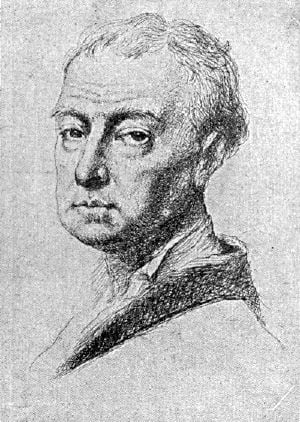Samuel Richardson
Samuel Richardson (August 19, 1689 – July 4, 1761) was a major 18th century writer best known for his three epistolary novels: Pamela: Or, Virtue Rewarded (1740), Clarissa: Or the History of a Young Lady (1748) and Sir Charles Grandison (1753).
Richardson had been an established printer and publisher for most of his life when, at the age of 51, he wrote his first novel — and immediately became one of the most popular and admired writers of his time.
Early life
Richardson was born in 1689 in Mackworth, Derbyshire. His mother, Elizabeth, was a woman “not ungenteel” and his father (another Samuel) was a joiner from Surrey, described by his son as “of middling note." As a boy apprenticed in a printer’s shop, this author earned the nickname “Gravity” and “Serious,” apropos of his later novels. At the age of seventeen, in 1706, Richardson was forced to begin a seven-year apprenticeship under John Wilde as a printer, an employment that Richardson felt would “gratify my thirst for reading”. By 1715, he had become a freeman of the Stationer's Company and citizen of London, and six or seven years after the expiration of his apprenticeship set up his own business as a printer, eventually settling in Salisbury Court.
Marriage and Children
In 1721 Richardson married Martha Wilde, the daughter of his former employer. His wife died on 23rd January 1731, following the deaths of five of their six children. The last child survived its mother by only two years. In 1733, following the death of this child, Richardson remarried. His second wife Elizabeth was also a daughter of a former employer, John Leake. Together they had six children (five daughters and one son). Four of their daughters reached adulthood and survived their father.
First Publication
In 1733 he wrote The Apprentice’s Vade Mecum, urging young men like himself to be diligent and self-denying. Written in response to the “epidemick Evils of the present Age”, the text is best known for its condemnation of popular forms of entertainment including theatres, taverns and gambling. The manual targets the apprentice as the focal point for the moral improvement of society, not because he is most susceptible to vice, but because, Richardson suggests, he is more responsive to moral improvement than his social betters.
Publication of Pamela
Pamela describes "virtue" in an 18th-century way that is foreign to our times. Pamela Andrews is a young maidservant in a wealthy household. The son of the household, Mr B., conceives a passion for her and repeatedly schemes with his servants to have his way with her. She protects her virtue successfully and B., moved in her favour when he reads the journal she has been keeping in secret, is forced to propose to her if he is to have her.
The popularity of Pamela was mainly due to the effective technique of revealing the story through letters written by the protagonist. Because this was combined with the moralistic nature of the story, which made it acceptable for the century's rapidly growing middle class, the book became a publishing sensation. The epistolary form was an innovation that was a source of great pride for Richardson. Pamela thus helped reinvent a literary genre that had developed a very questionable reputation. Nevertheless, many contemporary readers were shocked by the more graphic scenes and by some questionable behaviours of the characters; it was easy to regard Pamela, for example, as a scheming young woman trying to gain higher social status by making a nobleman marry her. Henry Fielding parodied Pamela twice: once anonymously using the same epistolary form in Shamela, and again with Joseph Andrews, which tells the story of Pamela's brother Joseph and his efforts to protect his virtue.
Other works
Richardson also wrote two later epistolary novels, Clarissa: Or the History of a Young Lady (1748) and Sir Charles Grandison (1753). Of the three, Clarissa has generally been the most highly regarded by critics; in it, Richardson uses the epistolary form with great effectiveness, creating characters that are psychologically convincing while reflecting on some of the most important moral questions of the 18th century. (See Clarissa for a summary of the novel.)
Sir Charles Grandison is Richardson's attempt to create a male model of virtue. Many modern critics have found that he was less successful here, noting that Sir Charles is not a very interesting or sympathetic character and that his confident sense of virtue can be cloying to the modern reader. In addition, the plot is relatively less eventful and the moral lessons less ambiguous than in Clarissa. However, in its own time Sir Charles Grandison was again a success (and was one of Jane Austen's favorite novels).
Richardson was widely considered one of the most important novelists of his age, influencing writers such as Jane Austen, Goethe, and Rousseau.
External links
- Works by Samuel Richardson. Project Gutenberg
Credits
New World Encyclopedia writers and editors rewrote and completed the Wikipedia article in accordance with New World Encyclopedia standards. This article abides by terms of the Creative Commons CC-by-sa 3.0 License (CC-by-sa), which may be used and disseminated with proper attribution. Credit is due under the terms of this license that can reference both the New World Encyclopedia contributors and the selfless volunteer contributors of the Wikimedia Foundation. To cite this article click here for a list of acceptable citing formats.The history of earlier contributions by wikipedians is accessible to researchers here:
The history of this article since it was imported to New World Encyclopedia:
Note: Some restrictions may apply to use of individual images which are separately licensed.
